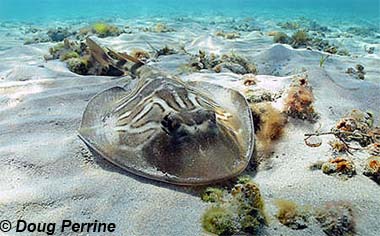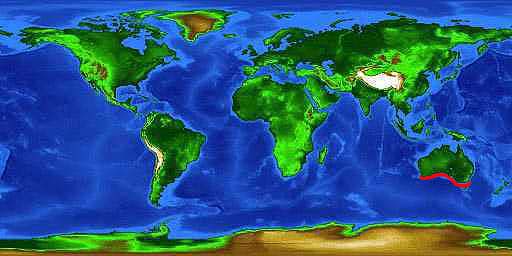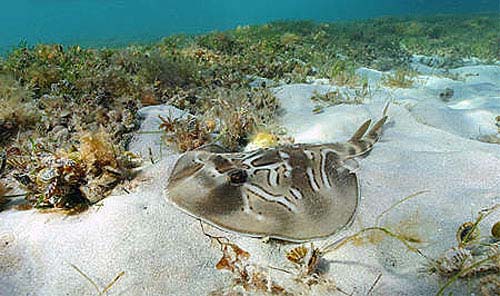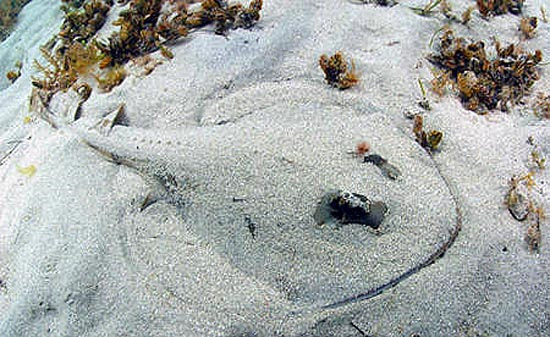Southern Fiddler

Trygonorrhina fasciata
This oval shaped ray has a very rounded pectoral disc that is dark yellow-brown on top with irregular grayish bands outlined in darker brown. The long tail has two small dorsal fins and an asymmetrical caudal fin, and the total length of this ray, including tail, can be as much as 50 inches.
They live on the sandy or rocky bottoms of coastal Australia, usually hiding in the sand or scavenging for crustaceans and invertebrates to eat.
Order – Rajiformes
Family – Rhinobatidae
Genus – Trygonorrhina
Species – fasciata
Common Names
English language common names are southern fiddler, banjo shark, Dumeril’s shovelnose ray, fiddler, fiddler ray, green skate, magpie ray, parrit, and southern fiddler ray. Other common names include geigenrochen (German), skovelnäsa (Swedish), sydlig violinfisk (Danish), and zuidelijke vioolrog (Dutch).
Importance to Humans
Although the flesh is considered good to eat, only a small quantity is sold in seafood outlets and it is of only minor commercial fisheries interest. The southern fiddler is often caught as bycatch in commercial fisheries as well as by recreational fishers. It adapts well to captivity and is often on display at public aquariums. This ray is often observed around jetties and wharves by SCUBA divers.
Danger to Humans
The southern fiddler is considered harmless to humans.
Conservation
The southern fiddler is currently listed as “Least Concern” with the World Conservation Union (IUCN). The IUCN is a global union of states, governmental agencies, and non-governmental organizations in a partnership that assesses the conservation status of species. A listing as “Least Concern” indicates that this species does not qualify for “Endangered”, “Vulnerable”, or “Near Threatened”. This category includes widespread and abundant species; this ray is considered relatively abundant throughout its geographic range.
> Check the status of the southern fiddler at the IUCN website.
Although there appears no urgent need for conservation measures to protect this species, it does occur in some protected marine reserves and sanctuaries in waters off Victoria and South Australia.
Geographical Distribution

This ray is endemic to the waters off southern Australia from eastern Bass Strait to Lancelin off Western Australia including the waters of Victoria, northern Tasmania and South Australia in the eastern Indian Ocean. It appears to be common throughout its range.
Habitat
The southern fiddler is quite common along the coast over sandy bottoms and seagrass beds adjacent to rocky reef habitat. This ray resides at depths ranging from the intertidal zone down to 591 feet (180 m).
Biology

Distinctive Features
A medium-sized shovelnose ray, the southern fiddler has an oval disc that measures less than the tail length. The translucent snout is semi-circular, relatively short and broadly rounded with nostrils partly covered by a fleshy internasal flap. These nostrils are connected to the mouth by a groove. The mouth of this species is almost straight to slightly convex and the eyes are very small.
The dorsal fins are separated by approximately the horizontal length of the first dorsal fin or slightly less. They are about equal in size with the first dorsal fin originating behind the pelvic fin placement. The lower lobe of the caudal fin is poorly defined in this species. The tail is almost semi-spherical in cross section and is rather depressed and broad-based.
Coloration
The dorsal surface, dorsal, and caudal fins of the southern fiddler are dark yellowish brown with distinct dark margined blue-gray transverse bands which do not form a triangle between the eyes. These bands radiate posteriorly and laterally from the eyes, mid-disc region and longitudinally behind the eye as three distinct stripes. There is a darker band between the eyes, extending forward to the disc margin which is more prominent in juvenile than adult specimens. The disc and pelvic fin margins are pale in color as are the ventral surface and lateral skin folds along the hind margin.
A similar species occurring in the same geographical region is the eastern fiddler (Trygonorrhina sp.), which is found on the east coast from southern Queensland to the eastern Victorian border. The coloration of this species is easily distinguished from the southern fiddler by its coloration. It’s body is brown interspersed with shades of yellow or olive. There are pale lilac-colored bands with dark margins as well as a distinctive triangle between and behind the eyes.
Another close relative of the southern fiddler is the magpie fiddler (T. melaleuca), however the range of this rare species is very limited to the shallow waters of St. Vincents Gulf, South Australia. It can be distinguished from the other two Trygonorrhina species by the absence of thorns around the eyes as well as its bluish black coloration on the dorsal surface.
Dentition
The mouth of this ray contains numerous, small, blunt teeth used for crushing hard prey including shellfish.
Dermal Denticles
Large, thorn-like denticles are present along the dorsal midline of the southern fiddler’s disc. There are single preorbital, postorbital, and spiracular thorns as well as three rows of thorns on the shoulder area with the outer row being the longest. Denticles cover the bases of these thorns, forming small mounds.

Size, Age & Growth
The southern fiddler reaches a maximum total length of 50 inches (126 cm); the maximum published weight of this species is 14.8 pounds (6.7 kg). The length at maturity is far greater for females at approximately 35.1 inches (89.2 cm) while males mature at an approximate length of 26.7 inches (67.8 cm).
Food Habits
The southern fiddler preys primarily on shellfish, crabs, and other bottom-dwelling invertebrates that they are able to crush between their powerful jaws. Neonate feed on mysids, carids, pinnotherids, amphipods and isopods.
Reproduction
In the waters off southwestern Australia, this ray gives live birth in April and May which is presumably when ovulation and fertilization occurs. It produces 4 to 6 young per breeding cycle. Although the gestation period is 12 months, the embryos grow rapidly only during the final four to five months. This delayed development is referred to as embryonic diapause.
Predators
Larger bony fishes and sharks living within the same geographical area are potential predators of the southern fiddler.
Parasites
The southern fiddler is parasitized by three monogenean (platyhelminth) species from three families on three different sites of the host: Calicotyle australis (Monocotylidae) from the cloaca, Pseudoleptobothrium aptychotremae(Microbothriidae) from the skin and Branchotenthes octohamatus (Hexabothriidae) from the gills.
Taxonomy
The southern fiddler was originally described as Trygonorrhina fasciata by Müller & Henle in 1841. Synonyms include Rhinobatus dumerilii Castelnau 1873, Trygonorhina fasciata guanerius Whitley 1932, Trygonorhina guaneria Whitley 1932, Trygonorhina guanerius Whitley 1932, Trygonorrhina guaneria Whitley 1932, and Trygonorrhina guanerius Whitley 1932. It is a member of the family Rhinobatidae, a name which originates from the Greek “rhinos” meaning nose and “batis, -idos” referring to a ray. This family is represented throughout the world by four genera and approximately forty species, being the most diverse in the Indo-West Pacific region. This ray is one of three living species within the genus Trygonorrhina, all endemic to Australian waters.
Prepared by: Cathleen Bester